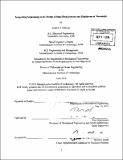Integrating seakeeping in the design of semi-displacement and displacement monohulls
Author(s)
Gillespy, Andrew J
DownloadFull printable version (15.30Mb)
Other Contributors
Massachusetts Institute of Technology. Dept. of Mechanical Engineering.
Advisor
Paul Sclavounos.
Terms of use
Metadata
Show full item recordAbstract
Early stage ship design and assessment continues to be a challenge for naval architects and ocean engineers. The complex and multifaceted interactions between the different components of the ship and the broad spectrum of disciplines required in ship design make it difficult to fully realize the effects of any one change on the entire system. The initial design of smaller patrol craft is especially difficult due to the lack of design tools able to deal with ships of small size operating in the semidisplacement region. Furthermore, seakeeping at high speeds cannot be reliably calculated by traditional methods such as strip theory due to the hydrodynamic effects that occur in the semidisplacement region. Traditional methods have a vessels' response in seas calculated after most initial design decision have been cemented, making changes in design for improved seakeeping difficult at best. This paper puts forth a method for narrowing the design space for semidisplacement and displacement patrol craft operating at Froude numbers up to Fn= 1.0 and incorporating the vessels' response in seas into early stage design. Optimization of the design is done through the use of response surface methodology. Using a systems approach, a Patrol Craft Assessment Tool (PCAT) was created and tested to aide designers in the initial design and assessment of patrol craft of < 90 m. PCAT is an MATLAB code that interfaces with Surface Wave Analysis (SWAN2) to incorporate resistance, engine selection, structures, seakeeping, and mission profiles into one design program to aide a designer in optimizing a patrol craft and understanding the engineering tradeoffs.
Description
Thesis (Ph. D. in Ocean Engineering)--Massachusetts Institute of Technology, Dept. of Mechanical Engineering, 2010. Cataloged from PDF version of thesis. Includes bibliographical references (p. 99-100).
Date issued
2010Department
Massachusetts Institute of Technology. Department of Mechanical EngineeringPublisher
Massachusetts Institute of Technology
Keywords
Mechanical Engineering.